Now in your cart 0 items
Artists
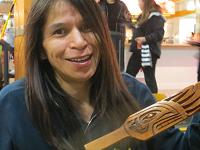 Alex Mountain5 products
Alex Mountain5 products
ALEX MOUNTAIN is a member of the KwAGiulth nation of Mamalillikulla, British Columbia. He lives in one of the affordable/supportive housing complexes created by the City of Vancouver to help reduce homelessness and the risk of homelessness. He carves in his small and crowded room, complete with bath and kitchen area, specializing in red or yellow cedar plaques. They may be as small as a hand or several square feet in size. He usually uses mahogany stain and then brown liquid shoe polish to finish the pieces, buffing them with a soft cloth..jpg) Bert Azak1 products
Bert Azak1 products
Bert Azak is from the Nisga’a Nation of Northwest British Columbia. Bert was born and spent his early days in the village of GitwinksihLkw (“Gitwinsilk”). His family moved several times in his childhood, from Port Edward to Prince Rupert to other communities in the Nass Valley. It was in Grade 9 that Bert was introduced to art, when Stan Russ, an Ahoushat artist, gave several classes to the children. Bert simply caught on, and his family was very encouraging; in fact, his father was both a carver and painter, as was Bert’s eventual father-in-law. Bert Azak completed high school, and went on to take several college courses, combining his art work with his development as a community relations worker in the justice and correctional systems. He keeps up with his art, though there are times when his employment takes him away from it and a piece may languish quite awhile in a cupboard, waiting to be completed and brought forward for collectors. Bert’s style is very congruent with what is generally known as NorthWest Coast Aborginal art – the flowing lines, the substantial use of start black and white, the use of animal imagery to embody a story of sorrow, joy, humour, creation and death.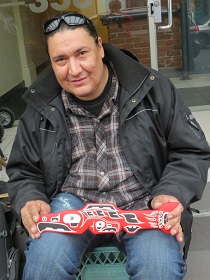 Chris Turo4 products
Chris Turo4 products
Chris Turo is a Dene man, from the NorthWest Territories. Though this is his origin, he grew up in Toronto, living with extended family. He began carving in his 20's, learning from older carvers. Interestingly, one of his mentors is the uncle of Len McKay, another of the Indian Art carvers. Chris works in yellow spruce, liking its fine grain and almost white natural colour.Darrel Amos22 products
DARREL AMOS is a member of the Haida First Nation. This is a source of great pride for him. He spends most of his time in the Downtown Eastside of Vancouver, sometimes in a stable housing situation and sometimes moving from place to place. He has been an artist since childhood and has been very much influenced by elder artists he has known along his varied life. He keeps in close contact with his family in Haida Gwaii and often returns when there are family crises, or special events to celebrate. He specializes in dramatic depictions of Haida crests and symbols -- clans, mythical creatures, and traditional stories. He uses acrylics and varies the colours of the background paper or canvas.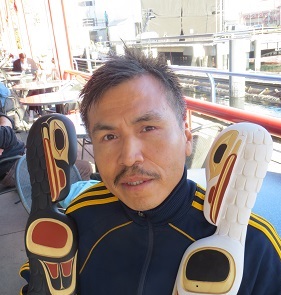 David Gonzales8 products
David Gonzales8 products
David Gonzales is a member of the Squamish Nation and Cowichan peoples. He has been a carver since he was about 12 years old, though when he as as young as 6 his eyes were opened to Northwest Coast art, and he fell in love with the style. He loves its expressiveness and depth. He works mostly with yellow cedar, because he prefers the very fine grain and its brilliant almost white colour. He also has worked in glass and paints as well. He finds that doing art "helps me in my solitude."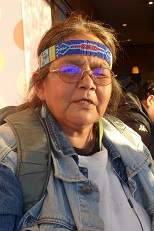 Doe Sam1 products
Doe Sam1 products
Doe Sam is of the Kwanlin Dun nation, and is a member of the Wolf clan. She was born in Whitehorse, Yukon, but her “home” was many foster homes from infancy on. Doe experienced many of her young years being moved from placement to placement in cities across western Canada. She ran away from these situations at 13, and as she says, “started learning to survive on the street.” As a young adult she came to Vancouver and has been there ever since. Doe Sam specializes in beadwork, learning her art as so many Aboriginal artists do, by watching a relative who is an artist and learning from them. In spite of Doe’s life on the edge from childhood, there have been times when Doe and her mother were together. Her mother was a beading artist herself and Doe would sit and watch her mother work on moccasins. Doe was allowed to bead the tops of moccasins her mother made. Doe has taken up beadwork only in the last few years, as part of her survival strategy and because she loves it. She focuses on very “useable” or “wearable” works. The base is usually moose hide, and the pieces are very practical, sturdy bags or pouches that hold cell phones, wallets, small cameras, and personal items. There are also headbands and wrist bands. Doe Sam’s beading craft is constantly evolving as she continues to learn both her craft and how best to reach out to those who value traditional Aboriginal art.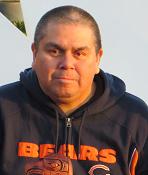 Edwin Wadhams3 products
Edwin Wadhams3 products
Edwin Wadhams is a member of the Namgis First Nation, from the Alert Bay are, in the far north of British Columbia. He lives in downtown Vancouver. Though he comes from Alert Bay, Edward has spent most of his life in Vancouver. He has a number of family members here. His father was a carver and his mother was the creator of the traditional "button blankets." Edward has lived with various members of his extended family from time to time and now is actively engaged as the caregiver for his brother, who was blinded in a vehicle accident some years ago. They are firm companions, living together in supported housing. His brother, who was an artist, is contemplating ways he may become an active one again, no matter if mostly sightless now. Edward works mainly in yellow cedar, buying blocks of wood and cutting them to size to begin his very impressive carved figures.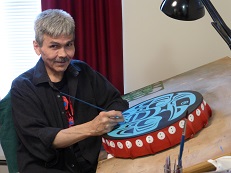 Eric Parnell10 products
Eric Parnell10 products
Eric Parnell has become active as an artist just over a decade now, yet his artistic heritage as a member of the Eagle clan of the Haida Nation goes back many centuries. He has worked at many jobs over his life, but making simple sketches, “doodling,” as he calls it, was always a pleasure for him. His partner, also very artistic, began to notice his talent and encouraged him to devote more to his drawings and to show them to the public. He took her advice. Eric describes himself as “self-taught,” saying that “books were my teachers.” He studied the traditional Haida art forms in the books on this subject, learning the formal descriptions of the shapes and subjects of paintings and carvings and adapting and creating his own distinctive paintings within this tradition. He also began to share with other artists, absorbing their examples, their suggestions, but always following his own inner vision of what he wanted to portray. Eric Parnell’s work is well-known for many public art projects. He specializes in limited edition prints, though originals can be acquired also. Eric also applies his impressive talent to drums, garments, table tops, and ceremonial gear.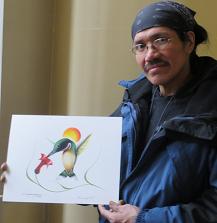 Garnet Tobacco12 products
Garnet Tobacco12 products
Garnet Tobacco is a Cree artist, originally from Manitoba. He was heavily influenced by his artist mentor, Isaac Bignell. Garnet's work does appear in galleries but he also sells from the street, which is how he became a part of Indian Art From The Edge. His dramatic, almost dreamlike pieces are created using sponges - the small ones on stick handles used for edging in house or room painting. First he outlines the work, makes a "template," and then builds up the colours he needs, leaving the white spaces, and then using narrow paint brushes to extend the image in sweeping lines. The style is more akin to other Aboriginal/Indian artists of the east, such as Norval Morrisseau.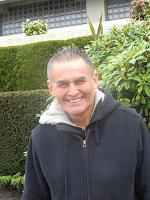 George Matilpi3 products
George Matilpi3 products
George Matilpi is a carver by vocation. He is of the Kwakiutl Nation, from Alert Bay. in his late 50's now, he began carving at 15. He learned from his oldest brother. All of his family are artists, though they work in silver. George comes in and out of the downtown of Vancouver, and is well-known among the other artists for his work. George creates forceful, colourful, precisely wrought carvings of traditional crests and totemic figures.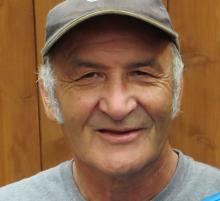 Gil Daniels2 products
Gil Daniels2 products
Gil Daniels is a member of the Athabasca Chipewyan First Nation -- the People of the Land of the Willow. This Land is the huge delta of the Peace and Athabasca Rivers, in the Northwest Territory of Canada. Gil has lived and worked all his life north of the Arctic Circle. He began carving using wood, but about 15 years ago his work evolved to creating in soapstone and alabaster, in what is generally known as Inuit style. He lives in Ft. Smith with his family, with both his wife and one of his growing children also being carvers. Gil builds up an inventory of pieces and then he and the family drive in a truck all the way to the West Coast (where he met Marylee, through one of the other Indian Art From The Edge carvers), to sell his pieces. Then they return home to continue building up another storehouse of beautiful works. Gil carves using the Foredom power carving grinder, which incorporates many different drill bits, to create large and small shapes and incisions. He matches the colours of stone to the object portrayed white alabaster for beluga whales, wonderstone for black pieces, blue alabaster for ocean.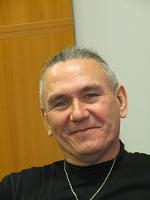 henry hawkfeather4 products
henry hawkfeather4 products
Henry Hawkfeather is of the Shawanga First Nation, near Barrie, Ontario. He has worked at various highly physical jobs off and on over his life. He recently came to Vancouver from the East, and is living at the edge of stability of living circumstances. However, he is rapidly meeting other artists who share his deep artistic interests. Now in middle age, Henry Hawkfeather has begun “following my pathway†to his Native roots. He had a dream that he would be an artist and he even saw some of his dancing figures in his dream. Henry has been doing his art for less than two years, having met a very experienced non-Native artist who helped him get started, working with coloured pencil, sometimes shading the colours with a vegetable oil. That allows him to “stream†the colours across the paper. Henry Hawkfeather’s pieces available from Indian Art from the Edge are on either “sketch†or heavier paper, with most of that paper being acid-free.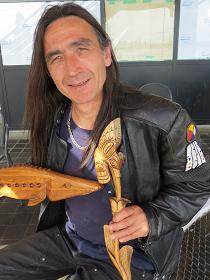 Jay Coutts1 products
Jay Coutts1 products
Jay Coutts is from the Nakazdli Band, from Cape Mudge, near Fort St. John, in the far northeast of British Columbia, near the Alberta border. He is a member of the Carrier Nation. Though Jay Coutts can now speak of his home nation and community, it was not until he was adult that Jay learned his Aboriginal status, and what his home Nation and community are. He was part of the “’60’s Scoop,†where between 1960 and the mid-1980’s, over 20,000 Aboriginal children were taken from their biological parents and community and placed in non-Aboriginal homes. In many cases, children were literally scooped by child welfare authorities from their homes and communities without the knowledge or consent of families and bands. Jay left his adoptive home as he became a ‘teen and has been searching for his biological and cultural roots ever since. As a carver he combines what he knows of Northwest Coastal art traditions, at the same time, creating his own particular versions of these traditions. His carving is powerful, explicit, and evocative of the roots which he continues to discover and bring to life.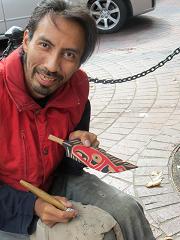 Len MCKay3 products
Len MCKay3 products
LEN MCKAY is a carver, and a member of the Coast Salish peoples. He often carries out his work while sitting on e stool on the sidewalk in front of a store in the upscale tourism part of the Downtown Eastside of Vancouver. He chats easily with people, explaining the piece, its story, the legendary characters is portrays. He also carves pieces such as "talking sticks," used by a speaker in a meeting, to hold their "space" in the discussions. Most talking sticks are indeed rather like walking sticks, but Len also makes some about the size of a hand, that sit on their edges, easily seen on a desk or meeting table, and easily passed from one speaker to another.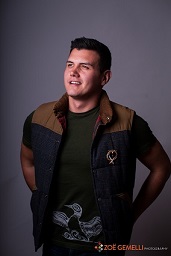 Patrick Hunter2 products
Patrick Hunter2 products
Patrick Hunter is a young Ojibway painter from Red Lake, Ontario. He's a neo-Woodland painter drawing inspiration from Norval Morrisseau & Daphne Odjig, as well as the Group of 7 painters. Patrick’s Ojibway Spirit name is Kewadinaang, translated as North Star. Patrick draws on his sense of the mystical to convey the essential spirit of those he portrays – whether human, animal, or of the Spirit World. His paintings have intense colours, flowing lines, and a blend of the “real” and the “spiritual” – there is no defining boundary to his imagination or talent. Patrick Hunter has been an artist since his early teens, and was one of the youth involved in a youth-run studio space in Sault Ste. Marie. He coordinated a visual arts and music exhibition in 2013, which featured emerging young artists. He has studied graphic design in Sault College, and creates a wide range of paintings, limited edition prints, and designs for garments. As part of his community development activities, Patrick is engaged in a new venture called the 8th Fire Image Makers - a group of First Nations and Metis artists creating artwork that respects cultural traditions but moves forward in their own distinctive ways today. Patrick lives a very busy life, building his art career as a painter and graphic designer in Ontario and returning to Red Lake to sustain connection to the land that inspires him.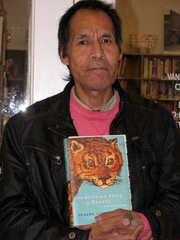 Ron Solonas16 products
Ron Solonas16 products
RON SOLANAS is a member of the Tsekani First Nation, from the Interior of British Columbia. He is noted for his complex, light-hearted line drawings, that are filled in with dramatic colours -- pinks, pale greens, deep blues. He works within the stylistic traditions of NorthWest Coast Aboriginal art, but also makes his own way in portraying anything from "honeybirds" (hummingbirds), to butterfly Christmas motif sketches, to play-on-words portrayals of "Justin Beavers" and eagles racing through thick birch forests to reach the streams containing their salmon prey. The book Ron is holding has a full-page reproduction of his three-colour drawing of a cougar, in Graeme Gibson's Bedside Book of Beasts, Doubleday Canada.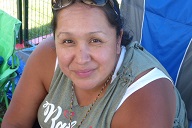 Siobhan Joseph2 products
Siobhan Joseph2 products
Siobhan Joseph is a young Squamish Nation woman, who is steadily building her reputation as creator of paintings that she describes as a reflection of both “traditional” styles of the Indigenous peoples of the Northwest coast of British Columbia and more “realistic” portrayals of animals in particular. Siobhan’s interest in art began when she was a pre-schooler. The Joseph family are renowned carvers, and she would spend hours and hours, day after day, observing her father, master carver Delmar Joseph. She was greatly encouraged by her mother from childhood. Siobhan thinks of her art as a way of honouring her now departed mother, of thanking her for the important role she played in strengthening Siobhan’s confidence and dedication to her art. For the last several years Siobhan has been able to devote her enormous energies to being an emerging entrepreneur. She received a business grant from the Squamish Nation facilitated her development of a rapidly expanding business of high-quality originals and prints of her paintings, and also producing stylish garments, cards, and costume jewelry—all her own designs. Indian Art from the Edge is delighted to be able to include Siobhan’s works in our gallery of original, authentic Indigenous art.Stephanie Kewistep2 products
Stephanie Kewistep’s family are originally from the Sauteaux peoples of eastern Canada, and was born on the Yellow Quill Reserve. However, Stephanie’s mother moved Stephanie and her three sisters to Vancouver when Stephanie was five years old. The Vancouver area has been home since then, and Stephanie is proud of having two very successful grown sons. Stephanie did not take up painting until adulthood, when she learned from her now ex-husband, a very talented Haida artist. Stephanie’s approach to her very distinctive painting is spontaneous, in that she will see some wildlife form in its natural setting – birds, frogs, even an inuksuk (stone guideposts on the tundra), and then “do my own interpretation.” She uses artist quality, thick “board” for her works. Because resources can be scarce, Stephanie has worked out an arrangement with a local framing store, who happily contribute the unused pieces of their framing boards, which make perfect bases for her art. Stephanie’s work could be seen as a synthesis of various traditional Indian art styles – she uses the ovals of the Haida artist, the flowing lines of the Woodland style – and makes each piece her own. The addition of Stephanie Kewistep to the Indian Art From the Edge artists is a story of time and luck. Years ago the owner/curator, Marylee Stephenson, saw two of Stephanie’s pieces and bought them from another artist, but there was no way to connect with Stephanie herself. Spreading the word, asking artist after artist over the years, did not work. Then just a few weeks ago, as Marylee was walking in the Downtown Eastside, meeting one of the Indian Art carvers – there was Stephanie, creating her paintings on the street, sitting on a bench beside the carver! So time and luck have paid off – and maybe a little patience.
Keywords: Aboriginal art, Indian art, First Nations, Haida, Tsekani, KwAGiulth, Cree, Coast Salish, West Coast, Coastal, British Columbia, BC, Canada, Lower Mainland, North Vancouver, Indian carvings, Indian paintings, carvings, drawings, jewelry, pendants, medallions, crests, clan, painting, carve, street art, online gallery, online store, online shop, shopping, gifts, homeless, Downtown East Side, DTES, Vancouver, poverty, vulnerable, at risk, near homeless, shelters, plaques, awards, fair trade, Marylee Stephenson.
There are currently no product reviews
